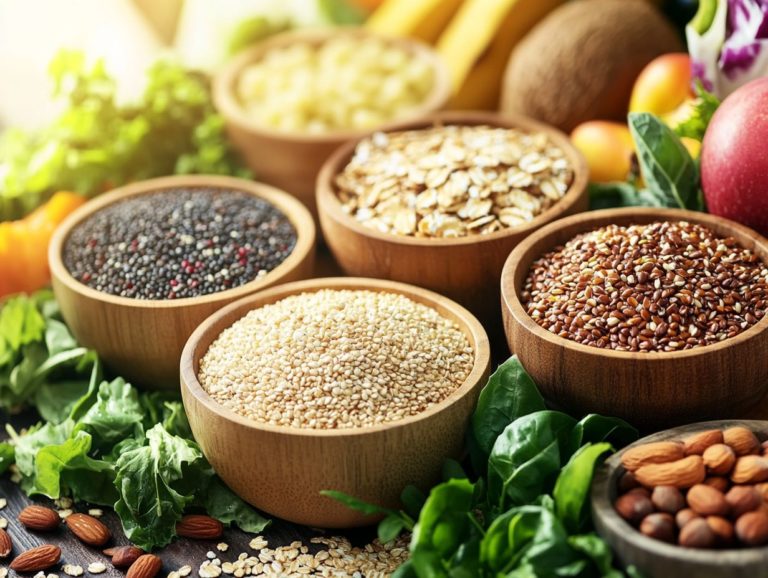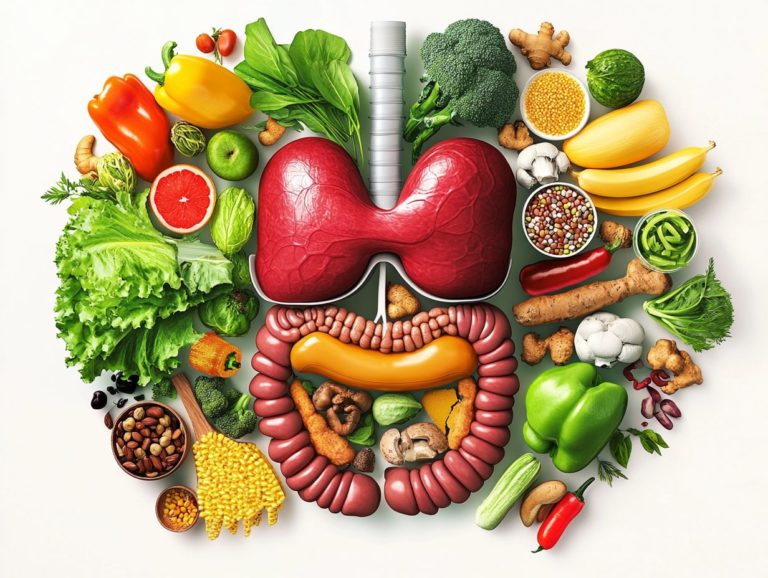The Role of Fiber: Why You Need It in Your Diet
Fiber stands as a cornerstone of a healthy diet. It significantly contributes to digestion and overall well-being.
This article delves into the different types of fiber, highlighting its myriad health benefits and the recommended daily intake.
Get ready to discover delicious high-fiber foods that will change your meals for the better! You ll also find practical tips for seamlessly integrating more fiber into your diet.
Explore how fiber supports weight management while considering the potential risks associated with excessive consumption.
Embark on a journey to unlock the secrets of this dietary powerhouse!
Contents
Key Takeaways:

- Fiber is an essential nutrient that helps maintain a healthy digestive system and overall well-being.
- Including high-fiber foods in your diet can improve heart health, aid in weight management, and promote regularity.
- It is recommended to consume at least 25-30 grams of fiber per day and gradually increase intake to avoid negative effects.
What is Fiber?
Fiber is an essential element of a healthy diet, representing parts of plants that your body can’t digest. It is vital for maintaining gut health, regulating blood sugar levels, and promoting overall metabolic well-being.
You can think of fiber as falling into two primary categories: soluble fiber and insoluble fiber. Soluble fiber dissolves in water to create a gel-like substance, while insoluble fiber adds bulk to your stool and aids in digestion.
Both types are critical for various bodily functions. They play significant roles in disease prevention, supporting gastrointestinal health, and lowering the risk of chronic conditions like heart disease and diabetes.
Types of Fiber
Fiber is classified into two types: soluble fiber and insoluble fiber, each offering unique health benefits.
Soluble fiber dissolves in water, transforming into a gel-like substance that can help lower cholesterol levels and stabilize blood sugar. This is particularly beneficial if you re at risk for heart disease or diabetes. You can find this type of fiber in foods like oats, beans, lentils, and certain fruits, such as apples and citrus.
In contrast, insoluble fiber doesn t dissolve in water but plays an essential role in digestive health. It promotes regular bowel movements and prevents constipation. Whole grains, nuts, seeds, and the skins of fruits and vegetables are excellent sources of this type.
Together, these dietary fiber types work in harmony to enhance your overall well-being, supporting everything from cardiovascular health to a thriving gut.
The Importance of Fiber in Your Diet
The significance of fiber in your diet cannot be overstated. It plays a crucial role in enhancing gut health, regulating blood sugar levels, and supporting overall metabolic function. For a deeper understanding of fiber’s importance, check out what is the role of fiber in holistic nutrition? These elements work together to lower the risk of chronic diseases like heart disease and diabetes.
By increasing your fiber intake, you unlock a range of health benefits, including improved cholesterol levels and enhanced digestive health. Therefore, it is essential to weave fiber-rich foods into your daily meals for optimal well-being.
Benefits for Overall Health
Fiber delivers an impressive array of health benefits. It aids in weight loss, maintains healthy cholesterol levels, and regulates blood sugar.
Beyond these advantages, fiber plays an essential role in promoting digestive health. It effectively prevents constipation and reduces the risk of gastrointestinal disorders. Those who embrace a high-fiber diet often experience better appetite control, which can naturally lead to a decrease in caloric intake and support their weight loss efforts.
Soluble fiber is particularly noteworthy, as it has been linked to lower cholesterol levels and enhanced heart health. Research suggests that increasing your fiber intake can significantly improve the healthy bacteria in your digestive system, ultimately contributing to your overall health and well-being.
Start today by adding more fiber-rich foods to your meals for a healthier you!
Sources of Fiber in Foods
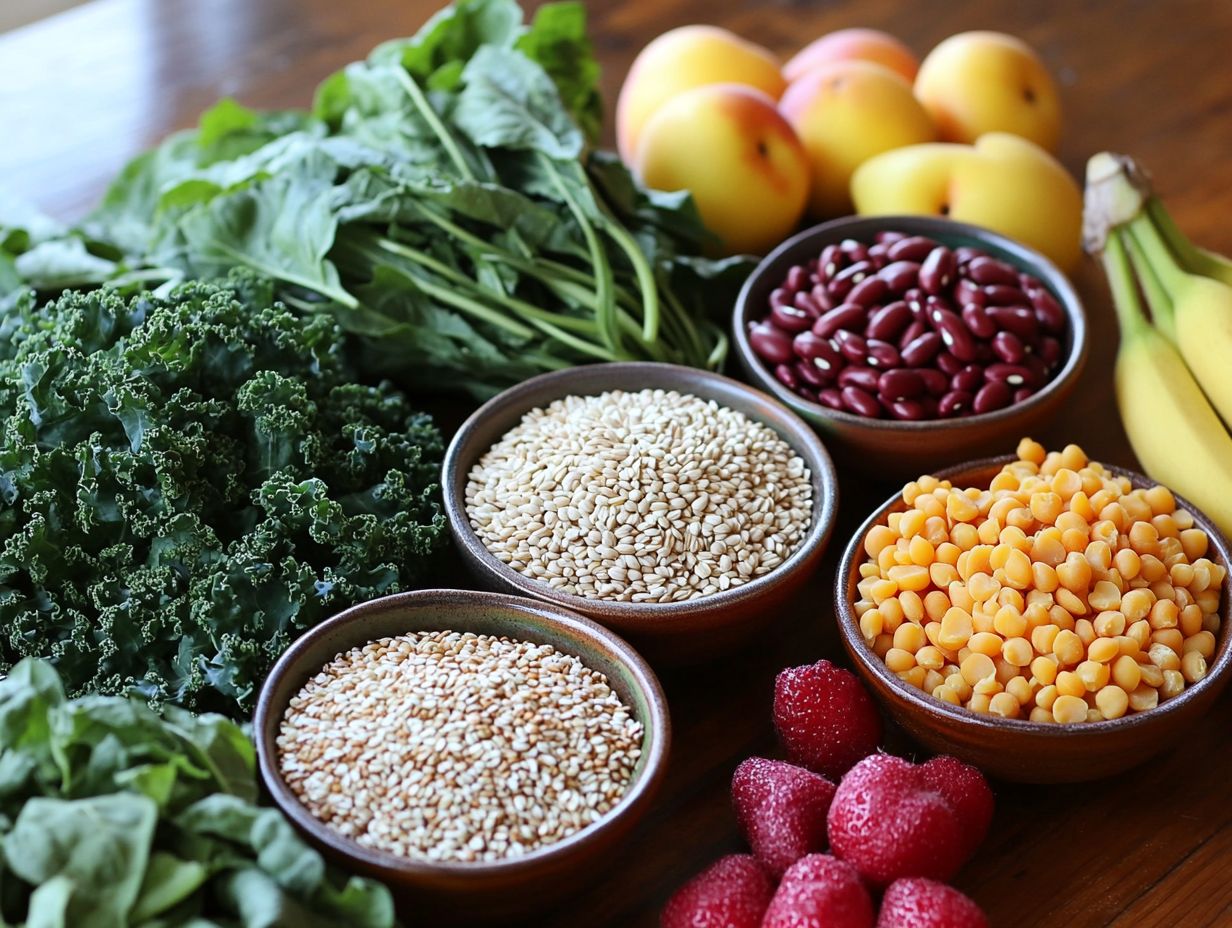
Incorporating a diverse array of fiber-rich foods into your diet is crucial for achieving your daily fiber goals. Enjoy the many health benefits that come with it.
Whole grains, fruits, vegetables, and legumes are exceptional sources of fiber, each offering distinct nutrients that bolster gut health.
Embracing these foods enriches your meals and supports your journey towards optimal health.
High-Fiber Foods to Include in Your Diet
High-fiber foods are critical for a well-rounded diet. They include whole grains, fruits, vegetables, and legumes, which are abundant in dietary fiber.
Incorporating these nutrient-rich options promotes digestive health and supports maintaining a healthy weight. It also reduces the risk of chronic diseases.
Take oats, for instance; their high soluble fiber content can significantly lower cholesterol levels. Meanwhile, black beans pack an impressive 15 grams of fiber per cup, making a notable contribution to heart health.
Integrating these foods into your daily meals can be remarkably straightforward. You can easily swap refined grains for whole-grain alternatives, add a vibrant array of fruits and vegetables to your plate, or include a handful of nuts or seeds as satisfying snacks.
By making these simple adjustments, you can effortlessly boost your fiber intake and enhance your overall well-being.
Daily Recommended Intake of Fiber
The daily recommended intake of fiber shifts with age and gender. Adults should strive for a minimum of 25 grams of fiber each day.
By adhering to these recommendations, you can prevent fiber deficiency.
How Much Fiber Do You Need?
Understanding your fiber needs is essential for maintaining a healthy diet. Generally, adults should aim for at least 25 to 38 grams of dietary fiber each day.
These requirements can vary significantly based on factors such as your age, gender, and level of physical activity. For example, younger adults and those who engage in regular exercise may need a higher intake to support their metabolism, which refers to the process your body uses to convert food into energy, and energy demands.
As people age, they often experience changes in digestion, which can influence their fiber requirements.
It’s important for you to assess your daily fiber consumption, keeping track of sources like fruits, vegetables, and whole grains.
By making thoughtful adjustments, you can effectively meet your personal dietary needs and enhance your overall well-being.
Ways to Incorporate More Fiber in Your Diet
Start adding more fiber to your diet today for a healthier tomorrow! It involves straightforward dietary strategies, such as selecting high-fiber foods and making intentional eating choices.
By prioritizing fiber-rich options, you can easily boost your fiber intake and enjoy the many benefits that come with it.
Tips for Increasing Fiber Intake
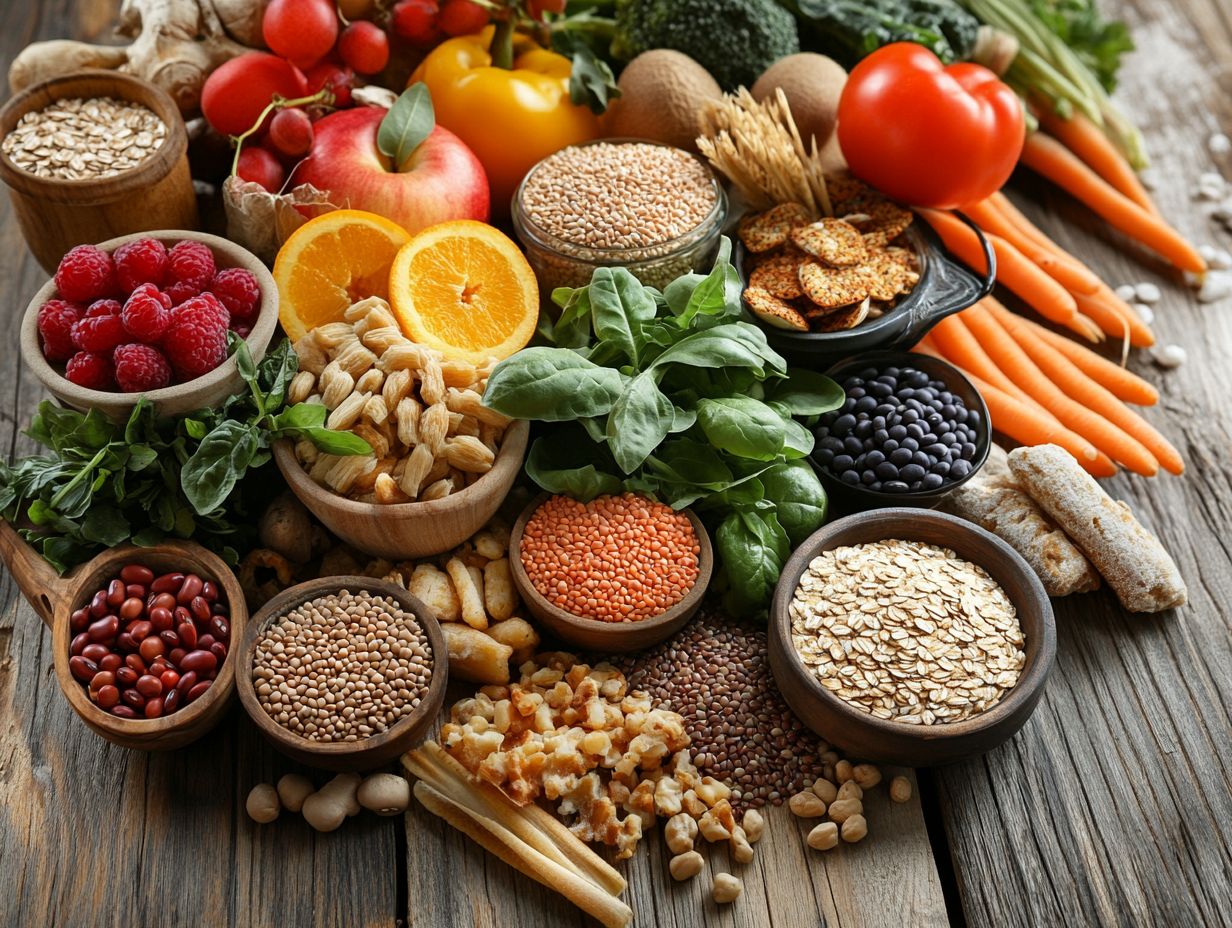
To elevate your fiber intake, try adding fiber-rich foods to your meals and snacks. Think legumes, whole grains, fruits, and vegetables as your allies in this journey.
Incorporating delightful dishes like quinoa salads, lentil soups, or overnight oats can transform your culinary experience. You might also find that adding chia seeds or flaxseeds to your smoothies or yogurt is an effortless way to boost fiber content.
For snacks, consider these options:
- Raw veggies with hummus
- Popcorn sprinkled with nutritional yeast
When you re in the kitchen, choose steaming or roasting vegetables over boiling. These methods keep the fiber in your veggies. Your meals will be tastier and healthier!
Remember, the key lies in gradual inclusion. This approach enhances your gut health and facilitates a smoother transition to a higher fiber diet.
Fiber and Weight Management
Fiber is an essential ally in your weight management journey. It enhances feelings of fullness, curbs overall calorie intake, and promotes healthy digestion. This makes it a cornerstone of any effective weight loss strategy.
By incorporating more high-fiber foods into your diet, you can manage your weight effectively while enjoying a delightful array of delicious options.
The Role of Fiber in Weight Loss
The role of fiber in your weight loss journey is significant. It helps control hunger and makes you feel full, leading to a natural reduction in calorie consumption.
Integrating high-fiber foods such as fruits, vegetables, whole grains, and legumes into your diet equips you with a powerful tool for effective weight management. These foods are not only low in calories but also packed with essential nutrients, enabling your body to absorb what it needs more efficiently.
Prioritizing fiber-rich meals helps you feel less tempted to snack between meals, naturally lowering your overall caloric intake. Fiber slows down digestion, leading to a steadier release of energy and a prolonged feeling of satiety both crucial elements for achieving sustainable weight loss.
Potential Risks and Side Effects of High Fiber Intake
While fiber is undeniably essential for your health, it’s crucial to know that excessive intake can pose potential risks and side effects. You might experience gastrointestinal issues such as bloating, gas, and constipation, especially if you increase your fiber intake too rapidly without ensuring proper hydration.
Understanding these risks is vital for managing your fiber consumption effectively and maintaining overall well-being.
How to Avoid Negative Effects of Excess Fiber
To avoid the downsides of excessive fiber, gradually increase your fiber intake while ensuring you’re well-hydrated to support healthy digestion.
This approach allows your digestive system to adjust more comfortably, reducing the likelihood of discomfort like bloating or gas. Include a diverse range of fiber sources think fruits, vegetables, whole grains, and legumes to nurture a balanced gut microbiome.
Pay attention to how your body reacts to these adjustments by maintaining a food diary or tuning in to how you feel after meals. This awareness can provide valuable insights. Pairing fiber-rich foods with plenty of hydration will help promote smoother bowel movements, keeping your digestive health in optimal condition.
Frequently Asked Questions
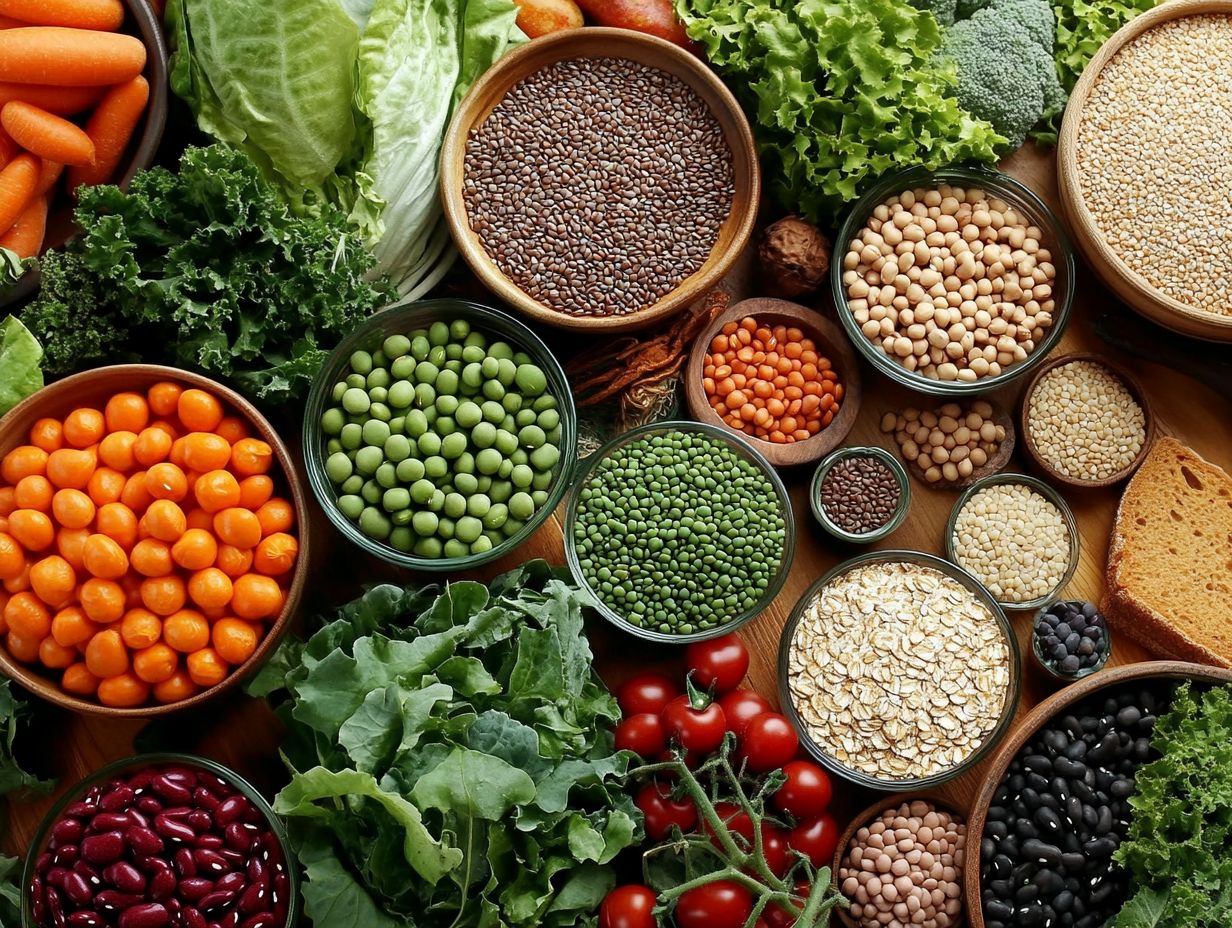
-
What is the role of fiber in our diet?
Fiber plays a crucial role in our digestive system. It aids in regulating bowel movements, maintaining a healthy gut, and reducing the risk of certain diseases.
-
How much fiber do I need in my diet?
The recommended daily intake of fiber for adults is 25-30 grams. However, this may vary depending on your age, gender, and overall health.
-
What foods are high in fiber?
Fiber can be found in a variety of plant-based foods, such as fruits, vegetables, whole grains, nuts, and seeds. Some examples include apples, broccoli, beans, oats, and almonds.
-
What are the health benefits of incorporating fiber in our diet?
Health benefits of fiber include improved digestion, lower cholesterol levels, reduced risk of heart disease, and better weight management.
-
Can fiber help with weight loss?
Yes, incorporating fiber-rich foods into your diet can aid in weight loss. Fiber promotes feelings of fullness and can reduce the intake of calorie-dense foods.
-
Are there different types of fiber?
Yes, there are two types of fiber: soluble and insoluble. Soluble fiber helps control blood sugar, while insoluble fiber aids in regular bowel movements.
Start adding fiber to your meals today for a healthier, happier you!



